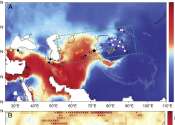NASA scientists gear up for solar storms at Mars
In the months ahead, two of NASA's Mars spacecraft will have an unprecedented opportunity to study how solar flares—giant explosions on the sun's surface—could affect robots and future astronauts on the Red Planet.









